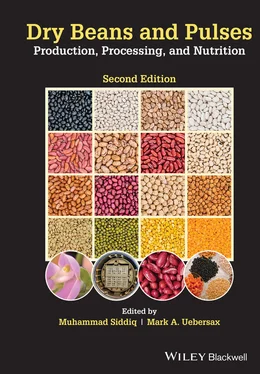Dry Beans and Pulses Production, Processing, and Nutrition
Здесь есть возможность читать онлайн «Dry Beans and Pulses Production, Processing, and Nutrition» — ознакомительный отрывок электронной книги совершенно бесплатно, а после прочтения отрывка купить полную версию. В некоторых случаях можно слушать аудио, скачать через торрент в формате fb2 и присутствует краткое содержание. Жанр: unrecognised, на английском языке. Описание произведения, (предисловие) а так же отзывы посетителей доступны на портале библиотеки ЛибКат.
- Название:Dry Beans and Pulses Production, Processing, and Nutrition
- Автор:
- Жанр:
- Год:неизвестен
- ISBN:нет данных
- Рейтинг книги:5 / 5. Голосов: 1
-
Избранное:Добавить в избранное
- Отзывы:
-
Ваша оценка:
- 100
- 1
- 2
- 3
- 4
- 5
Dry Beans and Pulses Production, Processing, and Nutrition: краткое содержание, описание и аннотация
Предлагаем к чтению аннотацию, описание, краткое содержание или предисловие (зависит от того, что написал сам автор книги «Dry Beans and Pulses Production, Processing, and Nutrition»). Если вы не нашли необходимую информацию о книге — напишите в комментариях, мы постараемся отыскать её.
The second edition of the most complete and authoritative reference on dry beans production, processing, and nutrition available Dry Beans and Pulses: Production, Processing, and Nutrition
Dry Beans and Pulses: Production, Processing, and Nutrition, Second Edition
Dry Beans and Pulses Production, Processing, and Nutrition — читать онлайн ознакомительный отрывок
Ниже представлен текст книги, разбитый по страницам. Система сохранения места последней прочитанной страницы, позволяет с удобством читать онлайн бесплатно книгу «Dry Beans and Pulses Production, Processing, and Nutrition», без необходимости каждый раз заново искать на чём Вы остановились. Поставьте закладку, и сможете в любой момент перейти на страницу, на которой закончили чтение.
Интервал:
Закладка:
83 USDA (United States Department of Agriculture). (2017b). United States Standards for Lentils. Available online at http://www.gipsa.usda.gov/fgis/standards/lentils.pdf(accessed July 21, 2020).
84 Voysest, O. (2012). Yellow beans in Latin America. Report 0084‐7747. Cali, Colombia: Centro International de Agricultura Tropical (CIAT).
85 Westphal, E. (1974). Pulses in Ethiopia, their taxonomy and agricultural significance. PhD Dissertation, Wageningen University, Wageningen, Netherlands. 273p.
86 Wiesinger, J.A., Cichy K.A., Tako, E. & Glahn, R.P. (2018). The fast cooking and enhanced iron bioavailability properties of properties of the Manteca yellow bean (Phaseolus vulgaris L.). Nutrients 10: 1609.
87 Wu, X., Beecher, G.R., Holden, J.M., Haytowitz, D.B., Gebhardt, S.E. & Prior, R.L. (2004). Lipophilic and hydrophilic antioxidant capacities of common foods in the United States. Journal of Agricultural & Food Chemistry 52: 4026–4037.
88 Xu, B.J. & Chang, S.K.C. (2009). Total phenolic, phenolic acid, anthocyanin, flavan‐3‐ol, and flavonol profiles and antioxidant properties of pinto and black beans (Phaseolus vulgaris L.) as affected by thermal processing. Journal of Agricultural & Food Chemistry 57: 4754–4764.
89 Zhong, L., Fang, Z., Wahlqvist, M.L., Wu, G., Hodgson, J.M. & Johnson, S.K. (2018). Seed coats of pulses as a food ingredient: Characterization, processing, and applications. Trends in Food Science & Technology 80: 35–42.
90 Zimmermann, G., Weissmann. S. & Yannai, S. (1967). The distribution of protein, lysine and methionine, and antitryptic activity in the cotyledons of some leguminous seeds. Journal of Food Science 32: 129–130.
4 Harvesting, Postharvest Handling, Distribution, and Marketing of Dry Beans
Mark A. Uebersax, Muhammad Siddiq, Joe Cramer and Scott Bales
Introduction
Harvesting and dry bean quality
Postharvest operations Conveying and transfers Receiving, cleaning, and separation
Dry bean storage and handling Bean storage facilities Bean drying and aeration
Packaging and market distribution Packaging systems for domestic shipmentsRetail polyethylene bags (1–5 pound) Commercial polypropylene bags (100‐pound) Bulk polyethylene totes (2000‐pound) Domestic rail and truck transit Packaging for overseas shipments
Marketing of dry beansMarket channels Marketing of organic vs. Conventional dry beans Marketing and promotion organizations
Postharvest storage quality Moisture content Storage temperature and time Off‐flavor development during transit/storage Postharvest losses
Bean handling and food safety
Summary
References
INTRODUCTION
Dry beans and other pulses are legumes crops of economic importance globally. The nutrient‐rich legume grains are consumed all over the world and are a staple in many countries of Central and South America, Asia, and Africa. The highest per capita consumption of legumes is in South Asia and Africa (Nyombaire et al. 2011; Maphosa and Jideani 2017; Kumar and Pandey 2020). Recent increased consumer interest in protein consumption and in plant‐based diet patterns offers opportunities for expanding dry beans and other pulses consumption (Gilham et al. 2018; Ahnen et al. 2019). However, postharvest losses are common in many developing countries due to poor infrastructure and inappropriate postharvest handling and storage (Njoroge et al. 2019).
The postharvest handling and storage of dry beans and other pulses is an important aspect in providing high quality products. Quality of beans during storage is susceptible to numerous of problems such as insects, mold, rodents, which warrant employing improved postharvest management throughout supply chain channels to preserve food safety and quality. It must be emphasized that dry beans require careful handling and monitoring to ensure stability throughout their postharvest life span. It must be clearly understood that it is important to move dry beans from field production to the final processing facilities in a controlled and sequential manner. Typical unit operations associated with the handling and cleaning of dry beans prior to receipt at the canning facility are shown in Figure 4.1 .
HARVESTING AND DRY BEAN QUALITY
Dry bean planting varying according to regional conditions. In Michigan, planting takes place between late‐May and early‐July, with about 75% planted in the first two weeks of June. Dry beans that do get planted in cold, wet soils typically struggle throughout the growing season fending off root diseases. In order to improve conditions at harvest time, growers “roll” bean fields between planting and emergence with a wide roller to flatten the field surface. This process presses any stones and rocks below the soil surface and flattens the surface, which enhances cutter bar efficiency and results in significant reduction stones, dirt balls and debris in the harvested beans (J. Cramer 2020, personal communication).

Fig. 4.1. Unit operations in raw dry bean handling and cleaning.
Dry bean seed is usually treated with a combination of insecticides to prevent loss due to insect pressures. These products are very effective but have a relatively short life. Growers utilize several methods to control weeds, which compete for moisture and nutrients. Most common is a pre‐plant application followed by a post‐emergence application if needed. Herbicide resistant weeds are becoming a greater challenge (Sprague and Everman 2017; Soltani et al. 2018). As the dry bean plant grows, the canopy covers the field and vulnerability to mold proliferation begins during the flowering stage. White mold ( Sclerotinia spp.) is the single biggest yield‐limiting factor in in dry beans in USA. Typically, fungicide is applied between the first flowers and earliest pod formation depending on field history and conditions. In certain circumstances, a second and occasionally a third application may be advantageous (Schwartz et al. 2011).
Most dry beans reach maturity in about 100 days, moisture content decreases as plants mature. Dry beans will store long term at moisture levels ≤18%. Maintaining good quality becomes more difficult when mechanically harvesting dry beans at the lower moisture levels. While the moisture level of the seed may be appropriate for harvest, often, the plant’s vegetative structures remain green, which complicates the harvest process, thereby compromising quality. To alleviate this detrimental condition, growers will often apply plant desiccants as harvest aids . Harvest aids kill the plant and significantly reduce plant moisture, and they improve the harvest process and overall seed quality (Knodel et al. 2019). Harvest aids work excellent in early September when daily temperatures are still warm, but efficacy declines when temperatures are cooler, and skies are more overcast during October (S. Bales 2021, personal communication). When harvest aids are used, strict preharvest intervals (PHI) between application and actual harvest are mandatory.
Early dry bean harvest is associated with maximum yields and complimentary to successful winter wheat planting. Dramatic changes in harvest technology have taken place from traditional “pull, windrow, thrash” to “direct harvest combining” (Eckert et al. 2011). Traditionally, this process has served the industry well over the years. The development of upright dry bean plant structure has led to direct harvest, allowing growers to spread the high cost of a combine over their wheat and soybean acreage and eliminating the need for pulling and windrowing equipment (Zyla et al. 2002). It is estimated that as much as 80% of the dry bean acreage in Michigan is direct harvested .
Читать дальшеИнтервал:
Закладка:
Похожие книги на «Dry Beans and Pulses Production, Processing, and Nutrition»
Представляем Вашему вниманию похожие книги на «Dry Beans and Pulses Production, Processing, and Nutrition» списком для выбора. Мы отобрали схожую по названию и смыслу литературу в надежде предоставить читателям больше вариантов отыскать новые, интересные, ещё непрочитанные произведения.
Обсуждение, отзывы о книге «Dry Beans and Pulses Production, Processing, and Nutrition» и просто собственные мнения читателей. Оставьте ваши комментарии, напишите, что Вы думаете о произведении, его смысле или главных героях. Укажите что конкретно понравилось, а что нет, и почему Вы так считаете.












